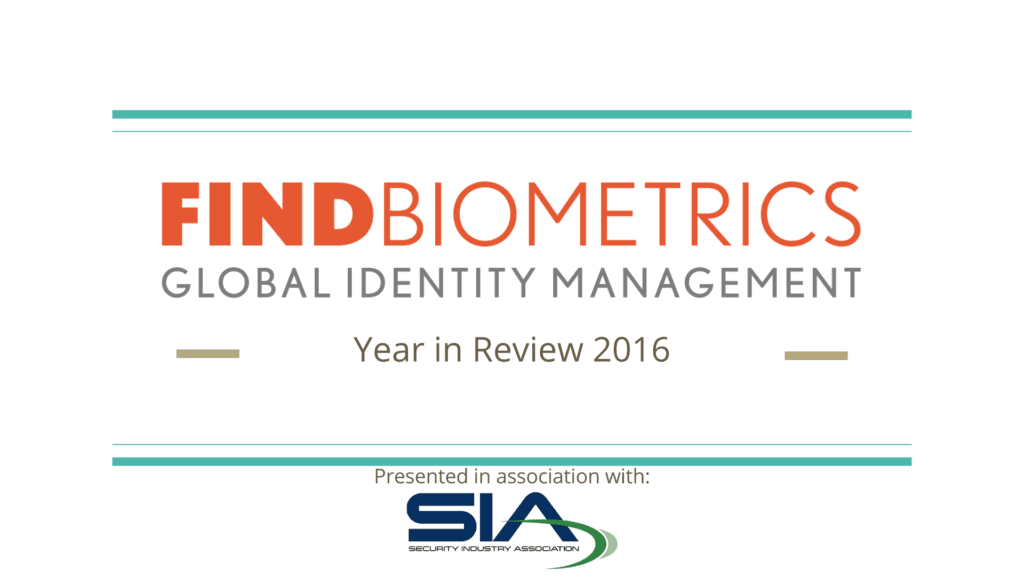 The 14th Annual FindBiometrics Year in Review has come to a close. In December of 2016 we surveyed 160 professionals in biometrics related industries to gauge their views on key identity and authentication topics, and over the past four weeks we released the results accompanied with our highly regarded expert analysis. The result is a snapshot of professional attitudes toward the constantly evolving biometrics landscape as we enter a new year that promises exciting developments in the realms of strong authentication, new generation security, identification, and consumer accessibility.
The 14th Annual FindBiometrics Year in Review has come to a close. In December of 2016 we surveyed 160 professionals in biometrics related industries to gauge their views on key identity and authentication topics, and over the past four weeks we released the results accompanied with our highly regarded expert analysis. The result is a snapshot of professional attitudes toward the constantly evolving biometrics landscape as we enter a new year that promises exciting developments in the realms of strong authentication, new generation security, identification, and consumer accessibility.
 Key details from the 2016 Year in Review concern highly active areas of application for biometrics. Financial services and consumer applications proved to be of high interest to our survey respondents—these are areas with a great deal of overlap, and can boast some of the most widely accessible uses cases of biometric technology. Border control was also of high interest, which is in line with longstanding forecasts of growth within that global market.
Key details from the 2016 Year in Review concern highly active areas of application for biometrics. Financial services and consumer applications proved to be of high interest to our survey respondents—these are areas with a great deal of overlap, and can boast some of the most widely accessible uses cases of biometric technology. Border control was also of high interest, which is in line with longstanding forecasts of growth within that global market.
We also observed a shift in attitudes toward favoring multimodal biometric technologies. While fingerprint biometrics have long been the poster-child of our industry, attitudes have been gradually changing as new technologies become more accessible. In 2016, financial services providers in particular championed the importance of choice when it comes to user authentication, and such sentiments echoed throughout other vertical markets including enterprise and the aforementioned border control arena. Of additional interest is the inclusion of relatively new modalities on the high levels of the interest scale, with behavioral biometrics receiving some enthusiasm.
At a glance, the FindBiometrics Year in Review results paint a positive picture of the biometrics industry at large, while also highlighting some of the key challenges moving forward into a future of strong authentication and next generation identity—examining the importance of liveness detection, the role of public perception, and key factors that must be addressed in the effort to eliminate passwords. The biometrics industry is multifaceted, diverse, dynamic, and more exciting than ever before, and as our survey results can support: 2016 was the first time biometrics technology truly felt mainstream.
– The FindBiometrics Editorial Team
Follow the links below to explore the results of the 14th Annual FindBiometrics Year in Review:
Year in Review 2016: An Introduction From Don Erickson, CEO, Security Industry Association (SIA)
Year in Review 2016: Biometrics Truly Feel Mainstream
According to our respondents, 2016 was the first year biometric technology truly felt mainstream.
Year in Review 2016: The Most Exciting Modalities
What were the most exciting biometric modalities in 2016? Here’s what our respondents had to say.
Year in Review 2016: Consumer Biometrics Are Still Nascent Tech
Consumer biometrics are more ubiquitous than ever before, but are they still in a nascent phase?
Year in Review 2016: The Priority of Liveness Detection
Should liveness detection be a priority in the consumer-facing biometrics industry?
Year in Review 2016: Public Perception
Does the public perception of biometrics play an important role in the future of the biometrics industry? We look at how biometrics entered the public discourse in 2016.
Year in Review 2016: Top Areas of Application Pt. 1
Financial services and consumer applications were voted as the most interesting spaces for biometrics in 2016. Here’s why.
Year in Review 2016: Border Control Applications
2016 was a big year for biometrics in border control.
Year in Review 2016: When Will The Password Die?
Are we on track to eliminate passwords by 2020? That depends on who you ask.
*
The FindBiometrics Year in Review is presented in association with SIA and made possible by our sponsor: Tascent


Follow Us